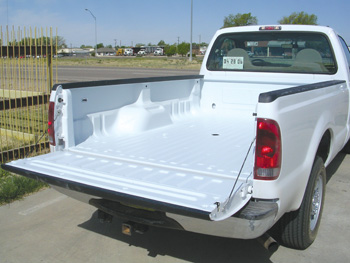 Add-on businesses give body shops opportunities to ring in sales rather than turning requests for sprayed-on bedliners, glass work, detailing and aluminum repairs to other outlets. But are you ready to expand your core business? And what’s the best service to add to your menu?
Add-on businesses give body shops opportunities to ring in sales rather than turning requests for sprayed-on bedliners, glass work, detailing and aluminum repairs to other outlets. But are you ready to expand your core business? And what’s the best service to add to your menu?
Truck Mania
With increased truck production now that the economy is loosening up, John Jamroz of Ultimate Linings in Houston, Texas, says the last 18 months have provided a solid market for sprayed-on bedliners.
“If you look at fleet sales alone, they have doubled from three years ago,” Jamroz says. “You’ve got more trucks on the road, but a lot of the mom-and-pop shops that did lift kits, bumpers, grills and everything else went out of business when sales were down at the dealerships, and now you’ve got the bigger shops left doing spray-on bedliners and [other add-ons].”
That means there are fewer places to get a sprayed-on bedliner today, Jamroz says.
And now, more trucks leaving the factory have bedliners, opening up repair work for body shops that are equipped to manage these jobs. Jamroz says 40 percent of Dodge Rams leaving the factory have bedliners. Increased exposure to bedliners also causes drivers to ask for the feature. Body shops that do sprayed-on bedliners can capture that business from dealerships if a partnership exists.
“You’ve got increased truck production, pent-up demand and increased exposure at the dealership- level – and lower operating costs,” Jamroz says of the perfect ingredients for a successful add-on business.
There are two sides to the bedliner business: installation and warranty work. “We offer two methods for body shops to maintain that profitability in-house – and often, it’s a [bedliner] repair,” Jamroz says.
With more vehicles, owners are spending today on add-ons, in general, making additional profit centers an investment to consider for body shops.
“We’re finally back to a point where people are investing in their vehicles,” says Dana Mitchell of Scorpion Coatings in Cloverdale, Ind.
 Breaking In
Breaking In
Is a bedliner business right for your shop? And, beyond protective coatings, what about other add-ons such as glass work or advancing current repair capabilities by investing in tools to do aluminum collision repair?
Some add-ons are admittedly outside of a body shop’s core business. A question to ask is: “Is it worth it – is there enough business there?” says Bob Olszak, USC product manager at Quest Automotive Products in Massillon, Ohio. Do you have the space to devote to a sprayed-on bedliner operation? (A devoted, screened-in area is necessary to avoid overspray.) Do you have the resources to train technicians and market the service? And how will the supplier/dealer assist with these tasks? What’s the market in your area? (Is the guy next door doing the same exact thing?) And is there opportunity for feeder business? Will dealerships and insurance companies send vehicles to your door if you offer the service?
Sprayed-on bedliners is one business option – but so is detailing, headlight repair and other side services that take up less space in a body shop that wants to test additional services before investing in new equipment.
Ease of use/operation is a key consideration as well. Olszak explains how Quest’s epoxy system offers more adhesion, corrosion protection and chemical resistance than other urethane options.
“Basically, these products are easier to prepare and apply, and while slightly slower to cure, there isn’t a huge [time] difference and it’s a simple, easy system to invest in if a shop wants to do bedliners,” he says.
Mitchell says body shops that want to test the waters can enter the bedliner business with low-pressure systems/kits and choose to advance their systems as they do more volume.
“It makes sense to crawl before you walk, and walk before you run,” he says.
The body shop start-up investment can be as low as $850 if you count an applicator gun and materials – less, in some cases, for kits.
With materials costs running about $150 for high-end products, and an average national bedliner installation price of about $550, the profit potential is certainly there, Mitchell points out.
Mitchell says the material cost for low-pressure systems is 20 to 30 percent higher (for Scorpion Coatings) than high-pressure materials. “But, there is no equipment investment,” he says. “Your spray guns will be $200 in the worst case.” A shop that does two or three trucks per month will be well served by this easy entry approach.
But once a shop starts spraying five to 10 vehicles a week, the volume justifies an investment in high-pressure equipment, Mitchell says.
“You have to ensure that you have that business long-term – if it’s a flash in the pan for a dealership you’re spraying for and you lose that business in six months, you’re stuck with a $30,000 equipment investment,” he relates.
For long-term volume, and an opportunity to continue growing the sprayed-on bedliner business, a body shop can do the math and make higher profits by getting into a high-pressure system.
Some good news: The cost to get a sprayed-on bedliner business going is much less today, Jamroz says. High-pressure equipment cost is less now through Ultimate Linings – about $16,500 compared to up to $28,000 – now that more machines are on the market for body shops to choose from, Jamroz says.
Not sure whether to start with low- or high-pressure application? Jamroz crunches some numbers. For a truck bed requiring six cartridges of product (and that’s a lot, he says) at $25/cartridge, materials for a single bed cost about $150.
Switching over to a high-pressure system, materials cost is approximately cut in half, but the application equipment costs more. “But if you’re doing 20 trucks per month and saving $75 per truck on materials costs, that’s $1,500 per month you’re saving, so in 11 months, you’ve paid for the equipment,” Jamroz says.
Volume justifies the investment – and cross-marketing can pump that volume up. Mitchell says shops can operate sustainable add-on businesses by partnering with dealerships and other suppliers that do not have a body shop on site. “They will get requests for bedliners and drive that traffic to you,” he says. “Work with the parts and sales departments, because they will push that [add-on] for you. If a salesperson feels like he can close a deal on a truck by offering a bedliner, he is going to promote that.”
Another strategy is to coordinate with local accessories retailers. “Have them drive their bedliner business to you, and create a nice bundle to drive the traffic back and forth,” Mitchell suggests, relating that body shops are generally not involved in bolt-on accessories and can reciprocate referral business by sending requests for these products to retail partners in their region.
Mitchell adds that shops should take advantage of social media and post specifically labeled photos (tagging the truck description, liner and material) of bedliner projects on Facebook and other outlets, which will get them recognized as local installers.
Enhancing the Core Business
Add-on businesses such as undercoating and restoration kits can be simple and take up little space. “You can use a single bay, the turns are quick and the revenues are high,” Mitchell says. He says many shops got away from this work in the last five years. “There wasn’t demand for it, and they focused on panel repair and paint.”
Undercoating and restoration costs less from a time and materials perspective, and can generate as much revenue and gross profit as full-on panel repair service, Mitchell says.
“Headlight restoration, window film and tinting are other options we offer that are a huge push for body shops right now,” Mitchell says, reiterating increased driver spending on vehicle add-ons. “Folks are spending more – we see that trending in the market here.”
Meanwhile, shops must also seriously consider their core business and how it will evolve with the increase in aluminum repair that will hit the market after fall when the No. 1-selling vehicle in the country, the Ford F-150, debuts.
“It’s a paradigm shift in auto body repair,” says Erik Spitznagel, CEO of Dent Fix Equipment, Gardena, Calif.
Dent Fix offers more than 50 different pieces of body shop-specific equipment for technicians, including those for aluminum repair. By 2025, 18 percent of vehicles on the road will be aluminum-paneled. “It doesn’t sound like a lot, but if Ford itself puts out 736,000 pickups per year, that’s a lot of repair,” Spitznagel points out.
A changeover in equipment could cost a shop $30,000 to $50,000, depending on the preparation required. But Spitznagel says this expanding field of repair will differentiate body shops from competitors – and how long can a shop ignore a significant stream of business? He compares the future influx of aluminum repair to a tidal wave. “It’s an aluminum wall coming toward us,” he says. Some shops will get the equipment to make aluminum repairs; those that dig their heads in the sand could get swept away by the wave of aluminum repair.
“For those who are forward-thinking and preparing their shop, it will allow them to direct the business for aluminum repair to their shops,” Spitznagel says, adding that as aluminum becomes more standardized, there will be demands that body shops repair and not just replace the panels.
Spitznagel acknowledges the range of add-on businesses that shops can choose from to increase revenues, from detailing to car rentals. But Dent Fix focuses on collision repair.
“That is the body shop’s business, so they need to focus on that and make sure they’re the best that they can be in the field,” he says.
Where Do You Want to Be?
Think about this: Where do you want your body shop to be in five years – and in 10 years? Set a goal. And be willing to take calculated risks in the name of driving more profit to the business.
“Analyze how much you can, and are willing, to invest to see if your facility can handle growth, then start looking for areas to explore,” Spitznagel says, relating to his own family’s business, founded in 1978 by his father. Dent Fix just moved into its third facility – the company started out with one piece of equipment, and now it offers 50-plus. Spitznagel offers this advice: “You have to allow yourself the opportunity to grow.”
Kristen Hampshire is a freelance writer based in Cleveland, Ohio.














